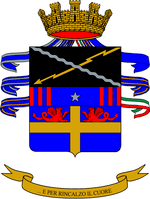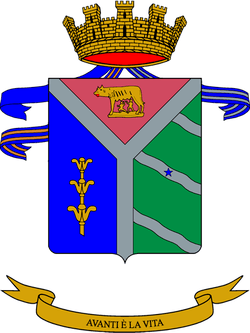Folgore Mechanized Division
| Divisione Meccanizzata Folgore | |
|---|---|
 Coat of Arms of the Folgore Mechanized Division | |
| Active | 25 September 1944 - 31 October 1986 |
| Country | Italy |
| Branch | Italian Army |
| Role | Armoured warfare |
| Part of | V Army Corps |
| Garrison/HQ | Treviso |
| Engagements | World War II |
The Folgore Mechanized Division was a mechanized division of the Italian Army. Its core units were three mechanized brigades. The brigades headquarters was in the city of Treviso.
History
World War II
The divisions history begins on 25 September 1944 with the formation of the Folgore Combat Group of the Italian Co-Belligerent Army with soldiers from the disbanded 184th Airborne Division Nembo. The name of the combat group was chosen in commemoration of the bravery of the 185th Airborne Division Folgore, which fought to annihilation in the Second Battle of El Alamein. The Nembo itself had been raised in 1942 with the Folgores 185th Parachute Infantry Regiment as its core unit.
The combat group consisted of the Nembo Parachute Infantry Regiment, the Italian Navy's San Marco Amphibious Infantry Regiment, the Folgore Parachute Artillery Regiment and the CLXXXIV (184th) Engineer Battalion. Each of the two infantry regiments consisted of three infantry battalions, a mortar company armed with British ML 3 inch mortars and an anti-tank company armed with British QF 6 pounder guns. The artillery regiment consisted of four artillery groups with British QF 25 pounder guns, one anti-tank group with British QF 17 pounder guns and one anti-air group armed with British versions of the Bofors 40mm gun.
Equipped also with British uniforms the Combat Group took part in the Italian Campaign of World War II as part of the British XIII Corps.
During the war the fascist regime in Northern Italy fielded the 1st Parachute Arditi Regiment Folgore, which also fielded a Nembo and a Folgore battalion.
Cold War
At the end of World War II the combat group was based in Florence. When the San Marco Regiment returned to the Navy on 5 September 1945 the combat group received the Garibaldi Regiment as replacement. The Garibaldi Regiment had been formed on 25 April 1945 in Viterbo with the re-patriated veterans of the Garibaldi Partisan Division, which had fought alongside the Yugoslav Partisans on the Yugoslav Front after the Armistice of Cassibile between Italy and the Western Allies. The Garibaldi Division was formed when the 19th Infantry Division Venezia on garrison duty in Montenegro refused to surrender or ally with the Germans. The Venezia together with men of the 1st Alpine Division Taurinense, who had refused to surrender too (mainly the Ivrea battalion and Aosta artillery group) saw heavy combat in Montenegro and out of its 16,000 men only 3,800 made it back to Italy. From these veterans the Garibaldi Regiment was raised with the battalions Aosta, Venezia and Turin.
On 15 October 1945 the combat group was elevated to division and began to move to the Northern Italian city of Treviso. As the Folgore along with the Mantova Infantry Division formed the first line of defence towards Yugoslavia it was augmented with the 5th Lancers Reconnaissance Battalion, the 33rd Artillery Regiment, the 41st Anti-tank Artillery Regiment and the 5th Anti-air Artillery Regiment. On 1 November 1948 the Garibaldi Regiment was renamed as 182nd Infantry Regiment Garibaldi, the Nembo Regiment was renamed as 183rd Infantry Regiment Nembo and the Folgore Artillery Regiment was renamed as 184th Artillery Regiment.
In 1949 the 5th Lancers was expanded to regiment and equipped with tanks, changing its name to 5th Armored Cavalry Regiment "Lancieri di Novara". In 1951 the division lost the 41st Anti-tank Artillery and the 5th Anti-air Artillery regiments and the became a fully motorized division in the following years. On 15 September 1955 the division received the 82nd Infantry Regiment from the Trieste Infantry Division. As the division fielded now three regiments with three motorized infantry battalions each the army decided to transform the Garibaldi regiment into an armored regiment. On 1 November 1958 the Garibaldi finished its transformation and became the 182nd Armored Infantry Regiment with a M47 Patton tank battalion and a mechanized Bersaglieri battalion. In anticipation of the transformation of the Garibaldi regiment the division had already lost on 1 April 1957 the 5th Armored Cavalry Regiment "Lancieri di Novara", which was used to raise the Pozzuolo del Friuli Cavalry Brigade.
On 1 January 1963 the army raised the Folgore Parachute Brigade in Pisa and both units were to keep the memory and traditions of the Italian airborne divisions of World War II alive. In 1964 it received the Reconnaissance Squadrons Group "Cavalleggeri di Saluzzo".
- Folgore Motorized Division, in Treviso

- Command Company, in Gorizia
- I Battalion, in Trieste
- II Battalion, in Cormons
- III Battalion, in Gorizia
- IV Mechanized Battalion, in Gorizia, with M113 armored personnel carriers

- Command Company, in Sacile
- XI Bersaglieri Battalion, with M113 armored personnel carriers, in Orcenico Superiore
- XIII Tank Battalion, with M47 Patton tanks, in Sacile
- Bersaglieri Anti-tank Company, with M40 recoilless rifles, in Orcenico Superiore

- Command Company, in Cervignano del Friuli
- I Battalion, in Villa Vicentina
- II Battalion, in Cervignano del Friuli
- III Battalion, in Gradisca d'Isonzo
- IV Mechanized Battalion, in Gradisca d'Isonzo, with M113 armored personnel carriers

- Command and Service Battery, in Treviso
- I Self-propelled Field Artillery Group, in Gradisca d'Isonzo
- II Field Artillery Group, in Gradisca d'Isonzo
- III Self-propelled Field Artillery Group, in Treviso
- IV Heavy Field Artillery Group, in Treviso
- V Light Anti-air Artillery Group (Reserve), in Treviso
- Artillery Specialists Battery, in Treviso

- Folgore Pioneer Battalion, Villa Vicentina
- Folgore Signal Battalion, in Treviso
- Folgore Light Airplanes Section, in Treviso, with L-19E planes
- Folgore Helicopter Section, in Treviso, with AB 206 helicopters
- Folgore Logistic Services Groupement, in Treviso
1975 reform
In 1975 the Italian Army undertook a major reorganization of its forces: the regimental level was abolished and battalions came under direct command of multi-arms brigades. As tensions with Yugoslavia over the city of Trieste were allayed by the Treaty of Osimo and because a reduction of the military service from 15 to 12 months for the army and air force and from 24 to 18 months for the navy, forced the army to reduce its forces by nearly 45,000 troops it was decided that the Motorized Division Folgore would contract to brigade. Therefore during 1975 most units of the Folgore division were either disbanded or reorganized and on 23 October 1975 the remaining units of the division were used to raise the Gorizia Mechanized Brigade in Gorizia. To bring the division back to full strength it received the Mechanized Brigade Trieste in Bologna and the Vittorio Veneto Armored Brigade in Villa Opicina. By the end of the year the division consisted of the following units.




- Amphibious Troops Command, in Lido di Venezia







- 47th Reconnaissance Helicopter Squadron Levrieri, in Treviso (former Folgore Helicopter Section)
- Folgore Command and Signals Battalion, in Treviso
- Folgore Artillery Specialists Group, in Treviso, (Counter-battery radars and drones) (merged Command and Services, and Artillery Specialists batteries of the 33rd Field Artillery Regiment)

- Folgore Medical (Reserve) Battalion, in Treviso
The division was disbanded on 31 October 1986 and its units came under direct command of the 5th Army Corps.
Today
The traditions of the Folgore divisions are today carried on by the Folgore Parachute Brigade, while the name of the Garibaldi division and regiment live on in the Garibaldi Bersaglieri Brigade.